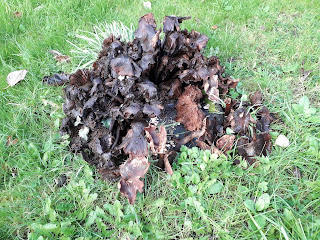September is peak crane fly time. I remember them appearing in the top corners of the tent when we went camping. They are attracted to light so they often come into houses at this time of year. They are quite harmless.
The one in the photo is a male; you can tell because the end of the body is blunt - square even. Females have a pointed end to the abdomen; this is so that they can deposit their eggs in the soil.
All flies have only two pairs of wings unlike most insects which have four. Instead of the second pair they have two drumstick-like organs called halteres which help with balance in flight. The halteres on common crane flies are particularly large and visible. In the photo below I managed to get one of the halteres in focus - almost.
Crane flies only live for 10 - 15 days so they have to get on with the business of mating and laying eggs a.s.a.p. You may see a pair joined end to end and when the female is laying eggs she bounces up and down on her spindly legs as she pushes her ovipositor into the soil. The legs are often damaged or missing, which doesn't seem to worry them.
The larvae are called leather jackets and are a menace because they feed on the roots of grasses and other plants. They are, however, an important source of food for hedgehogs, badgers, foxes and birds. If your lawn gets dug up it may mean that someone has been after leather jackets. What look like two eyes are actually breathing spiracles; the head is at the other end but they don't need eyes anyway as they live their whole life underground.
Photo: G Bradley on www.uksafari.com
Crane flies are also known as daddy longlegs but don't confuse them with cobweb spiders or harvestmen, which are also called daddy longlegs.




















































